
Dollars and cents: understanding currency in South America
One of the most difficult things about exploring a foreign country, in addition to navigating a new language, is decoding an unfamiliar currency. Although you’ll be able to use your credit card in just about any South American city, if you’re heading into the countryside, spending a lot of time at local markets, or simply want to avoid international transaction fees, you’ll need to know your way around domestic currency.
One country is tricky enough, but if you plan to see several destinations on your trip to South America, the complexities pile up. To help you out, we’ve compiled a currency cheat sheet for money in South America.
Quick Facts
The US Dollars is the official currency in Ecuador. US Dollars are also accepted in some places in Peru, mainly Lima and Cusco. In Peru, $20 is the most common US denomination; change will usually be returned to you in the local currency.
Only exchange or withdrawal small amounts of money at the airport; this is where fees are usually the highest and exchange rates the worst.
In general, it is best to have a combination of US dollars, local currency, and a credit card when traveling in South America (make sure you’ve checked your bank’s international transaction fees and let them know you’ll be using the card abroad).
Note that counterfeit notes are more common in Latin America than in the United State or Europe, and that many places will not accept bills that are well worn or torn.
In general Bolivia is the most affordable country to visit; Chile and Brazil are the most expensive.
Quick Navigation
Argentina - Peru - Suriname - French Guiana - Uruguay - Venezuela
Argentina – Argentine peso
The official currency in Argentina is the peso (AR$), which consists of 100 centavos. Paper bills come in denominations of 2, 5, 10, 20, 50, and 100 pesos; there are also 1, 2, and 5 peso coins.
As of July 2013, 1 USD=5.36 Argentine pesos
Argentina is currently experiencing a high rate of inflation and the government has imposed restrictions on its citizens regarding the purchase and use of the US dollar. As a tourist, you can exchange your dollars for pesos, but at the end of your trip you will not be able to exchange them back into dollars. Therefore you should only exchange or withdraw pesos as you need them to avoid being stuck with leftover currency at the end of your trip.
Inflation and a demand for US dollars have complicated the exchange rate in Argentina. If you exchange your money at an official location you’ll get the government’s fixed rate—which is also the lowest. The unofficial black market rate offers a much better deal, though we don’t recommend using any unofficial exchange houses. Your best bet is to use USD at hotels and restaurants, many of which are more than happy to accept dollars at the “blue market” rate.
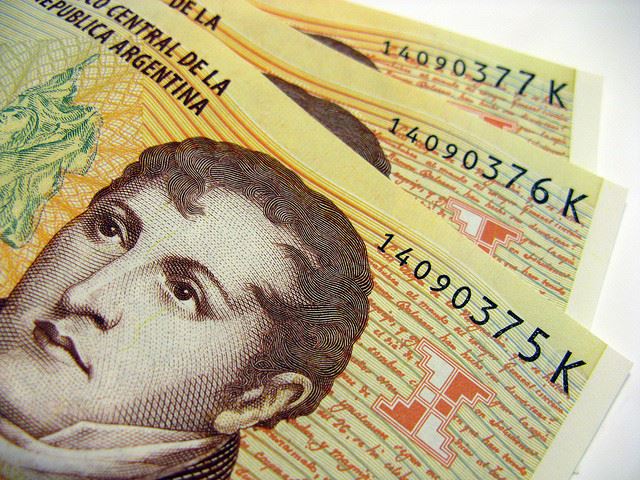
Bolivia – Boliviano
The official currency in Bolivia is the boliviano (Bs), though to make things confusing they’re sometimes referred to as pesos. Boliviano bills come in denominations of 10, 20, 50, 100, and 200 along with 1, 2 and 5 boliviano coins. One boliviano is equal to 100 centavos (cents). US dollars can be exchanged at some banks and at money exchange houses (called casas de cambio). Mastercard and Visa credit cards are typically accepted in cities. Bolivia is the poorest country in South America with one out of eight Bolivians living on less than US $1.25 a day.
As of July 2013, 1 USD=6.91 bolivianos
Brazil – Real
The currency in Brazil is called the real; plural it is reais (R$). In Portuguese that’s pronounced “hay-ow” and “hay-ice.” Bills come in denominations of 10, 20, 50, and 100. There are 100 centavos in a real; coins come in values of 1, 5, 10, 25, 50 centavos; there is also a 1 real coin.
As of July 2013, 1 USD=2.18 reais
The current currency was introduced in 1994 to end inflation. The original bill series from 1994 included 1, 2, and 5 reais bills. This series is still used, though the government began producing new bills in 2010 designed to counteract counterfeit bills. Note that written prices in Brazil use the period and common in reverse compared to the United States: A comma designates a fraction while a period designates thousands. For example, 5 reais would be written R$ 5,00 while 5,000 reais would be written R$ 5.000.
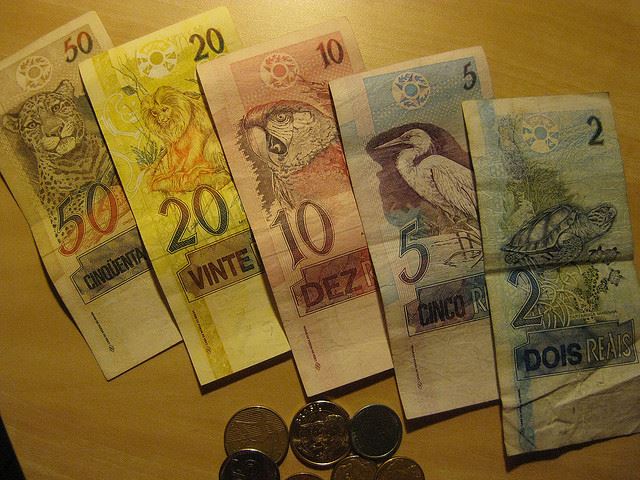
Chile – Chilean Peso
In Chile the currency is the Chilean peso, designated locally with a $ sign. Chilean money can be confusing for some because the denominations are so large. Bank notes come in denominations of 500, 1000, 2000, 5000, 10,000 and 20,000 pesos. Coin values are 1, 5, 10, 50, 100 and 500 pesos, although 1 and 5 centavo coins are rarely used and considered more or less worthless anywhere outside of a bank.
As of July 2013, 1 USD=503.5 Chilean pesos
Chileans commonly use slang to refer to specific bank notes. For example, a 1,000 bill is called a luca while 100 pesos is often called a gamba. Take a close look at any 50 peso coins: In 2008 a minting error printed “Chiie” instead of “Chile” on these coins. They’re still in circulation and considered a collectors’ item.
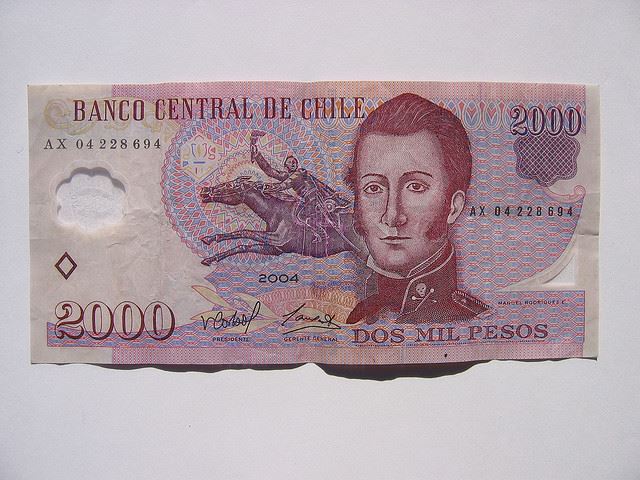
Colombia – Colombian Peso
In Colombia the currency is the Colombia peso, designated locally with a $ sign. Like in Chile, the local denominations are quite large. Bank notes come in 1,000, 2,000, 10,000, 20,000, and 50,000 pesos; coins are worth 20, 50, 100, 200, and 500 pesos.
As of July 2013, 1 USD=1919.5 Colombian pesos
It’s estimated that roughly 25% of all counterfeit USD comes from Colombia; be sure to check any US dollar bills you many receive while in Colombia to avoid being scammed.

Ecuador – US dollar
Ecuador’s official currency is the US dollar. All prices are marked in USD and all US bills and coins are accepted. Ecuador does mint its own centavo coins in denominations of 1, 5, 10, 25, and 50 cents which come in the same size as the corresponding US coins of penny, nickel, dime, quarter, and 50-cent piece. US one dollar coins (most recently the Sacagawea dollar) are more common in Ecuador than they are in the United States. Prior to 2000 Ecuador’s currency was the sucre.
Guyana – Guyanese dollar
Guyana is the third smallest country in South America and relatively isolated. Most goods are imported, making prices higher than would be expected. The official currency is the Guyanese dollar (G$). ATMs are not common.
As of July 2013, 1 USD=206.5 Guyanese dollars
Paraguay – Guarani
In Paraguay the official currency is the guarani, designed by the following symbol: â². The word guarani could also refer to the local Guarani language or the Guarani indigenous group.
As of July 2013, 1 USD=4,490 guaraníes
Banknotes in circulation include the following large denominations of 2,000, 5,000, 10,000, 50,000, and 1000,000. There are also coins, less common, in values of 50, 100, and 1,000 guarani. Due to inflation, cents are not used. The guarani is the least valued currency in the Americas, making Paraguay an affordable place for most people to explore.
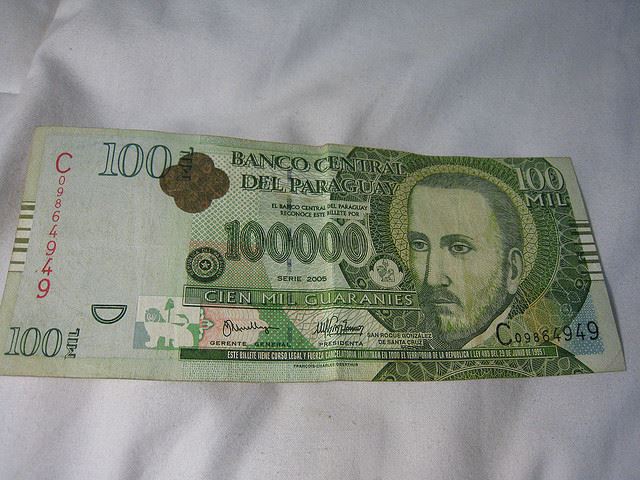
Peru – Nuevo Sol
The official currency in Peru is the nuevo sol, although it is commonly just called the sol ( S/.). Bills are printed in denominations of 10, 20, 50, 100, and 200. Coins are frequently used and come in values of 1, 2, and 5 soles. One sol equals 100 centavos, which come in 5, 10, 20, and 50 cent coins. Note that 5 (and the discontinued 1) cent coin are rarely used.
As of July 2013, 1 USD=2.78 Peruvian soles
US dollars are accepted in Lima and Cusco and in other large cities, though change will almost always be given in soles. ATMS and casas de cambio are common in Peruvian cities. Like most South American countries, there is a preference for smaller bills as vendors and taxi drivers are rarely able (or willing) to make change.
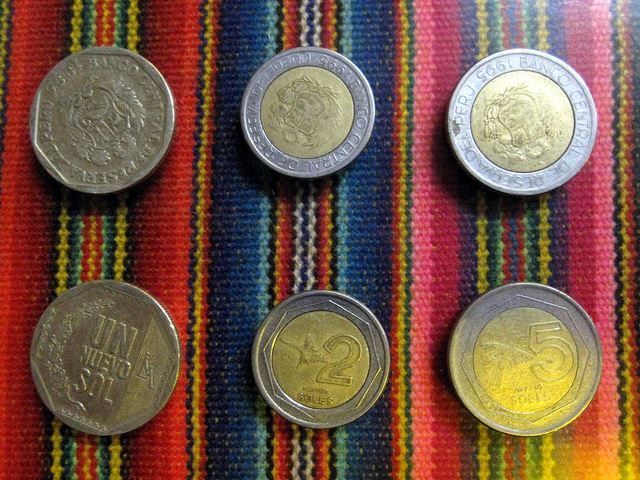
Suriname - Surinamese Dollar
In Suriname the currency is the Surinamese dollar, designed by the dollar sign $. This is a fairly new currency put into use in 2004. Bills come in denominations of 1, 2.5, 5, 10, 20, 50, and 100 dollars. One dollar equals 100 cents. Rather than minting new coins, old Surinamese guilder coins are still used; the guilder was Suriname’s previous currency. Sometimes electronics are priced in USD, while sometimes businesses quote in Euros.
As of July 2013, 1 USD=3.27 Surinamese dollars
French Guiana – Euro
Because French Guiana is an overseas territory of France, rather than an independent country, it follows France’s currency: the Euro. French Guiana is one of the most expensive places to visit in South America, with prices comparable to mainland France.
As of July 2013, 1 USD=.76 euros
Uruguay - Uruguayan Peso
Money in Uruguay is the Uruguayan peso (Ur$). Bills come in amounts of 20, 50, 100, 200, 500, 1,000, and 2,000 pesos; coins 1, 2, 5, and 10 pesos.
As of July 2013, 1 USD=20.25 Uruguayan pesos
Venezuela - Bolívar Fuerte
The official currency in Venezuela is the bolivar fuerte (Bs.F.) which replaced the bolivar (Bs) in 2008. The change was due to inflation and essentially adjusted prices by dropping the last three decimal places so that 1,000 bolivares equaled 1 bolivar fuerte. Bolivar furete banknote come in denominations of 2, 5, 10, 20, 50, 100 bolívares; coins are worth 5, 10, 12½, 25, 50 bolívares fuertes.
As of July 2013, 1 USD=6.28 bolivares fuertes
Venezuela by far has the most convoluted money system and it’s recommended you check for updated rates and regulations before travel to Venezuela. The Venezuelan government sets the exchange rates and has a two-tiered system for goods. There is also a thriving black market exchange much closer to the real exchange value. Travel in Venezuela on the government’s official exchange rate can be very expensive.
Thanks to Isaías Campbell for the title image of this blog.